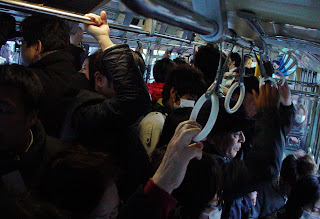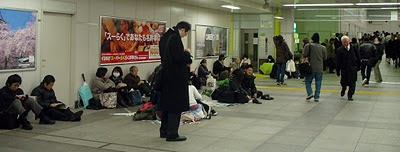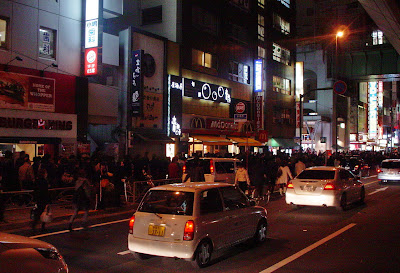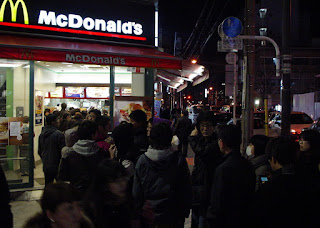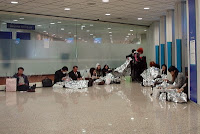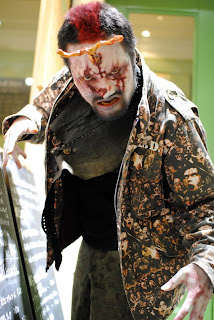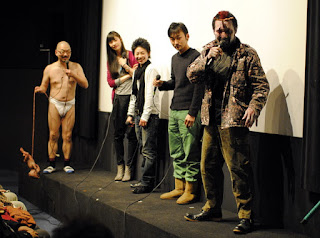 While my experience with the devastating quake of last Friday was in no way like that of those in Northern Japan, it is a day that will be impossible to forget. I am dedicating this blog entry to my personal experience.
While my experience with the devastating quake of last Friday was in no way like that of those in Northern Japan, it is a day that will be impossible to forget. I am dedicating this blog entry to my personal experience. For me, it began with a trip to Kasai, a town on the Tozai train line located in eastern Tokyo. On my way to a part-time gig, I wasn't a minute off the bus when I noticed that my feet weren't hitting the ground where I was aiming, like I was drunk at 2am and stumbling around in search of a cab home. But it wasn't yet 3pm, so that could hardly be the case.
Turning back to the bus stalled at the stop, I saw it was bouncing up and down, appearing to be almost leaving the ground at points. My balance became an issue, and I fell back onto a knee-high wall beside the sidewalk. Cars on the suburban street had stopped and jumped about like plastic toys. A child with her mom, on their way out from the restaurant behind me, was screaming hysterically, her cries barely audible over the din of every structure in the area bending and bulking as they rocked on their foundations. The quake intensified and I kept the power lines in sight that can kill as effectively as a falling building can. Not like I could dash away should a pole fall. Some insane, unseen force drove the ground, rolling and rising, like a rocky wave. Finally, the quake subsided. Traffic started up and I was back walking to work.
My job on this day was located in a local department store. When I arrived, the place had been evacuated, but I was allowed in to check on my working condition. Around the store, shelves were knocked over and glass was everywhere. Back outside I met up with a co-worker, and with her, experienced the first of many aftershocks that were to come. Work was canceled and I was told to make my way home. But how? I was 15 miles as the crow flies from where I live.
I set 3 stages to my journey home:
1) Akihabara Station
2) Shinjuku Station
3) Shimokitazawa
With buses not running, or at least not coming, I walked back to Kasai Station. As expected, the Tozai train line was out. People stood around the station, waiting for some kind of word. I asked a station man and was told to take a bus to Akihabara. I got on line, hoping buses would eventually show. A 1/2-hour later, buses began to appear, but only local ones, nothing heading into Tokyo. The line grew and grew. An hour went by. No one working at the bus line would say a thing. Finally, out of frustration, I went to the depot office. "What's going on?" I asked. "We don't know," was all they would say. I was pissed. It's OK to not know, but to not say anything only makes people nervous. So, there I was, the non-Japanese bringing the Japanese people on line who have been waiting and waiting some kind of news. Based on this, as I figured, some people went for other means to get home by buses with destinations different from Akihabara. Me, I had no choice. It was Akihabara or bust!
I thought to get a cab, but traffic was slow, and cabs, the few that there were, were all taken. But at last, a bus came an hour later. Quickly it filled to capacity - beyond capacity, actually. I just barely got on, pressed in by the front door.
I'm unsure how to describe the driver. Despite the bus being incapable of holding any more people, he drove to the first stop and opened the door as if it were a normal day of operation. Right away angry people outside began to demand that they be let on. "More can fit on! Make everyone move to the back!" A man outside yelled. Some even began pushing their way on, and as impossible as it seemed, three did, in fact.
I'm unsure how to describe the driver. Despite the bus being incapable of holding any more people, he drove to the first stop and opened the door as if it were a normal day of operation. Right away angry people outside began to demand that they be let on. "More can fit on! Make everyone move to the back!" A man outside yelled. Some even began pushing their way on, and as impossible as it seemed, three did, in fact.
Somehow the driver managed to get the door shut, but it seemed up to me to have to state the obvious, "Do NOT stop at another stop or else you're going to have trouble." The real issue for me was, why was only one bus dispatched? I saw some buses on the road with the "out of service" sign on. Considering the amount of people trying to move around it seemed to me buses were the best choice. It got so bad that when we did stop to let people out of the exit in the back of the bus, people outside forced themselves onto the bus through the exit.
The ride to Akihabara took nearly two hours. It's normally a 30-minute ride. We inched and inched along into the city. But Akihabara was no haven. The streets were full with displaced people and the JR train line was out. You could walk into the station, but unlike the workers at Kasai station, the JR people were clear: No more trains today. I hung around, looking at people lining the walls. No one seemed to have any idea what was going to come next, what they were supposed to do, or where they were supposed to go.
By this time I was getting hungry. I went into a 7-11 type store, shocked to find all the shelves stripped of food. Fortunately I found a "beef bowl" style restaurant across from the station, waited on line for 20 minutes, and when I finally was seated, ordered an extra large bowl, unsure when I would be eating again.
After eating I thought to get a bus to Shinjuku, but the lines were impossible, and it didn't matter since traffic was hardly moving. It seemed that walking was the only alternative. Oddly enough, there were no police around, and, in fact, no one you could say who was in authority. Typically in Japan, when you need help, you go to the police; here, you go for help, help doesn't come to you. I figured in a case like this it would be different, but it wasn't. Sure enough, I went to the station and outside the police were standing about offering advice to people.
The officer I spoke to gave me two options: spend the night at the shelter or walk. I debated spending the night in the local elementary school, but I really wanted to check on my apartment. My building is old, and though it seems very sturdy, who knows? Although my feet already were hurting from standing for the past several hours, I decided to walk anyway.
Following the directions given by the officer, I walked up to the main road he said went straight to Shinjuku. My jaw dropped when I found find it congested with people as far as I could see, with people on both sides all heading in the same direction.
What can I say? As a life-long movie fan, I was reminded of every alien invasion film I've ever seen where society breaks down and everyone tries to make it to some imagined safety zone.
With no options, it was my only choice. I begrudgingly got on line. Above, the moon shone down. Crescent shaped and bright white, it became tonight nature's guiding beacon, hanging high above an endless line of people trekking across the city of Tokyo. At least, I thought, trying to find the bright side, it wasn't raining; I was feed, and while cold, it wasn't winter like cold.
Along the way I was astonished to see absolutely no police presence. On the one hand you could say this reflects well on the Japanese people, as other than a looter in the department store at the start of this insane experience, everyone was behaving and making the most of it. But on the other hand, it's in moments like these that men dressed in uniforms give one the sense that society remains intact and that there is a plan of action being executed. The only time I saw police was at an intersection where the road to Shinjuku takes a confusing turn. Two officers were out with Darth Vader light sabers waving people in the correct direction.
What can I say? As a life-long movie fan, I was reminded of every alien invasion film I've ever seen where society breaks down and everyone tries to make it to some imagined safety zone.
With no options, it was my only choice. I begrudgingly got on line. Above, the moon shone down. Crescent shaped and bright white, it became tonight nature's guiding beacon, hanging high above an endless line of people trekking across the city of Tokyo. At least, I thought, trying to find the bright side, it wasn't raining; I was feed, and while cold, it wasn't winter like cold.
Along the way I was astonished to see absolutely no police presence. On the one hand you could say this reflects well on the Japanese people, as other than a looter in the department store at the start of this insane experience, everyone was behaving and making the most of it. But on the other hand, it's in moments like these that men dressed in uniforms give one the sense that society remains intact and that there is a plan of action being executed. The only time I saw police was at an intersection where the road to Shinjuku takes a confusing turn. Two officers were out with Darth Vader light sabers waving people in the correct direction.
Each step of the way was painful on my feet, and while I wanted to sit, I felt I just had to keep going, not knowing what the next moment would bring. Too many unknowns were going on around. The roads were lined with high-rise offices, and should another quake strike, would they come crashing down? Would the power go out? Cars were moving, but slower than the people walking. What if people got out and left their cars? And the line of people was intense; it couldn't handle anymore. Me, I just wanted to get to Shinjuku.
Several hours after leaving Akihabara I was finally nearing Shinjuku station. But then it struck me: And then what? It was still a haul to my town of Shimokitazawa.
Several hours after leaving Akihabara I was finally nearing Shinjuku station. But then it struck me: And then what? It was still a haul to my town of Shimokitazawa.
Shinjuku, like Akihabara, was another gathering point. The streets were congested with cars and the sidewalks with people. As along the way, people here could be seen wearing hard hats, and I even saw in the Citibank by the Kinokuniya bookstore people with silver emergency blankets getting ready to sleep in the lobby for the night. While some restaurants were open, most were not. And all the convenience stores were stripped of edibles. The one McDonald's open along the way had a long line out the door.
I walked over to the Keio line to see about a bus or a taxi. Forget the taxi: the line was over 300 people long! I asked at the bus depot about buses and the worker began telling me that buses had finished running for the night. WHAT? He said it was just too late for a bus. I guess he hadn't noticed that this was not an ordinary day. As I wrote earlier, buses are probably the best means of moving people around. They should be out in force! But then, fortunately, another worker said that the Keio train line had started up.
I rushed down the stairs to find the area before the Keio line entrance packed with people. Trains appeared to be running, but only local lines. People were being let in until a train filled and then the gates would shut. Guards stood by, directing people in. I worked my way up to the front and was let in with the next batch. "Don't run!" The guards ordered as we followed the stairs down.
Suddenly the buzzer that sounds when a train departs went off. In a panic, people began running for the train. The buzzer continued to blare as the train filled with people. And then, for no reason, it went off and we sat there for ten minutes. Excuse me? What was that buzzer for? Telling people not to run, and then edging them on with a meaningless buzzer is, at best, bizarre.
Suddenly the buzzer that sounds when a train departs went off. In a panic, people began running for the train. The buzzer continued to blare as the train filled with people. And then, for no reason, it went off and we sat there for ten minutes. Excuse me? What was that buzzer for? Telling people not to run, and then edging them on with a meaningless buzzer is, at best, bizarre.
Twenty minutes later I arrived at Shimokitazawa Station, aching feet and all. I was happy to see buildings in the area standing. My own building had a fresh crack on the stairs leading in, and when I opened the door to my room I was greeted with the unwanted sight of a toppled CD collection, and my DVDs covering over my bed. Luckily I had secured some furniture to the walls otherwise they would have come smashing down.
This was my second major quake in Japan, the first being the Kobe quake of '95. As with that, I consider myself lucky to get out in one piece. I have to be thankful that it was, for me, more an inconvenience than a life altering experience. It wasn't until the next day that I begin to see the images of destruction that people around the world were already privy too. I wept many times. The intensity and the meaninglessness of such destruction is a fate no one deserves. My heart goes out to all who died, were injured, or suffered a personal loss.


